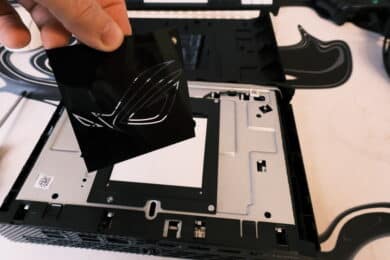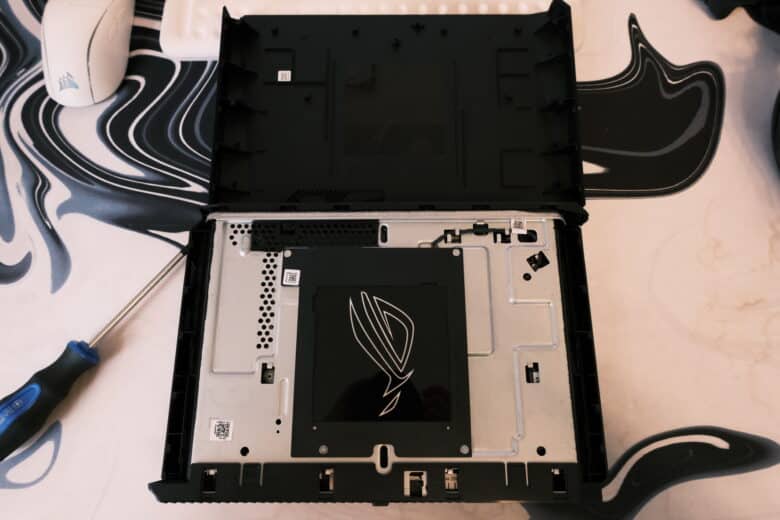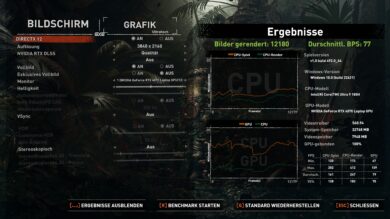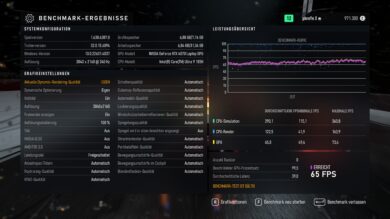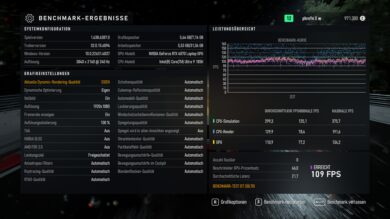
Gaming mini PC with RTX 4070
So here it is: the gaming-ready mini PC from ASUS ROG, which is finally available following its unveiling in July 2024. The compact 2.5-liter computer goes by several names: ASUS ROG NUC 14, ROG NUC 970 or NUC 14 ROG – but they all refer to the same device. We took a closer look at the mini PC in the top configuration with Intel Core Ultra 9 185H, RTX 4070 laptop GPU, 32 GB DDR5-5600 RAM and a 1 TB SSD in the test.
Technical data
| The product | |
| Processor | Intel Core Ultra 9 185H (16 cores, 3.8 – 5.1 GHz) |
| Graphics performance | Nvidia GeForce RTX 4070 (8GB GDDR6 VRAM); 140 W TDP |
| Storage space | 1 TB SSD (NVMe PCIe 4) installed |
| Working memory | 32 GB DDR5 RAM (2x 16GB DDR5-5600 SO-DIMM) |
| Operating system | Windows 11 Home |
| Connectivity | Wi-Fi 6; Bluetooth 5.3 |
| Dimensions | 270 mm x 180 mm x 60 mm |
| weight | 2.6 kg (without power supply) |
| Price | € 2,159.00 * |




€ 2,169.00
Bestellt, versandfertig in 7-13 Werktagen


€ 2,279.05
Auf Lager; Lieferzeit: 2 Werktage


€ 2,418.15
Auf Lager, 1-2 Werktage
ASUS ROG NUC 14 review: Compact, stylish and easy to maintain
The new ASUS ROG NUC 14 is visually reminiscent of the previous Intel NUC models before the division was taken over by ASUS. The new model bears the unmistakable signature of the manufacturer, which can be recognized not only by the illuminated ROG logo, but also by the futuristic lettering on the front and underside.
The mini PC measures 270 mm x 180 mm x 60 mm and weighs around 2.6 kilograms. It is up to you whether you want to use the computing dwarf horizontally or set it up vertically.
If you opt for the latter, you can place the ROG NUC in the stand included in the scope of delivery, which does not scratch the somewhat vulnerable housing thanks to its padded inner sides.
The illuminated ROG logo shines pleasantly discreetly through the semi-transparent case, under which it is present as a stencil. This can be freely rotated if desired, and the manufacturer includes additional stencils in the scope of delivery.
While the build quality gives no cause for criticism, the case is quite susceptible to scratches and fingerprints. If you want to keep the Mini-PC clean, you will have to polish it regularly.
Maintenance options and connections
Maintaining the ASUS ROG NUC 14 is child’s play. In fact, it’s even quicker and easier than you’re used to with mini PCs such as the Beelink SEI 14 (our test) and the like.
There is a switch on the back that can be used to quickly and easily remove the top panel of the Mini PC when it is flipped over. You can then pull the lid backwards and gain access to the aforementioned template.
To access the components, simply loosen the Phillips screw at the back and the upper section of the inner workings can be removed.


The 2.5-liter case then reveals the components. A total of three M.2 2280 slots are available for SSDs, and there are also two SO-DIMM slots for the RAM. The processor and GPU, however, are soldered, as the ASUS ROG NUC 14 relies on a mobile notebook board.
Connections of the ASUS ROG NUC 14
The ASUS ROG NUC 14 is also very well equipped in terms of connections. With one exception: the mini PC only has a single USB-C port, but with Thunderbolt 4 connectivity. Unfortunately, this doesn’t look quite as modern.
Otherwise, the connections leave nothing to be desired. On the front, the Mini PC has two USB 3.2 Gen2 Tye-A ports, a 3.5 mm jack and a full-size SD card reader (unfortunately only UHS1).
There are significantly more ports on the back:
- 1 x Thunderbolt 4 Type-C with DisplayPort 2.1
- 2 x USB 3.2 Gen 2 Type-A
- 2 x USB 2.0 Type-A
- 1 x HDMI 2.1
- 2 x DP 1.4a
- 1 x RJ45 LAN (2.5 GBit)
- 1 x DC-in
- 1 x Kensington Lock
The features of the ASUS ROG NUC 14
- Intel Core Ultra 9 185H
- RTX 4070 with 140 watts; 32 GB RAM
- Wi-Fi 6E; but connection unstable in places
The ASUS ROG NUC 14 is available in various configurations. Our test model comes with the Intel Core Ultra 9 185H processor, which runs with a TDP of 65 watts. It offers 6 P and 8 E cores and reaches a maximum of 5.1 gigahertz.
It also has 32 GB of DDR5-5600 RAM (2x 16 GB) and a 1 terabyte SSD. The mini PC is also gaming-ready thanks to an NVIDIA GeForce RTX 4070 laptop GPU, which comes with 8 Gbytes of GDDR6 VRAM and a TDP of 140 watts. This should therefore be absolutely sufficient for 1440p gaming.
The ROG NUC communicates wirelessly via Intel Killer Wi-Fi 6E and achieves very good speeds. However, the WLAN card proved to be somewhat unstable during my test. The connection was repeatedly interrupted for short periods – so short that you don’t notice much when surfing, but you do when downloading. So if you want to play competitive games, you should rely on a LAN connection.
Bluetooth 5.3 is also available for connecting other end devices. The RGB lighting can be synchronized with other ASUS ROG devices via AURA Sync.
Practical test, volume and heat development
- Pleasantly quiet fan noise
- Turbo mode without additional performance
- High temperatures, but mostly still within limits
What I initially noticed very positively in the practical test is that the ASUS ROG NUC 14 is pleasantly quiet even under continuous load. Even when gaming for several hours, the mini PC is much quieter than my large gaming PC – not to mention gaming notebooks, which can get deafeningly loud.
This applies to the default performance mode, as you can choose between four operating modes in the Armoury Crate software. These include a particularly quiet profile and a turbo mode, which is designed to boost performance even further.


.
It should, because in various gaming and benchmark tests I couldn’t find any difference between the “Performance” and “Turbo” profiles. In other words: absolutely none at all, not even 1 FPS more.
The temperature development is also kept within limits. Although CPU and GPU temperatures of around 80 degrees are reached under constant load, this is by no means a cause for concern. Only in the most demanding benchmarks does the CPU briefly reach the limit of 100 degrees and then reduce the clock rate slightly. If you want to counteract this, you can use the “Quiet” profile to reduce the temperatures by an average of 5-7 degrees without sacrificing too much performance.
The performance of the ASUS ROG NUC 14
- fast SSD
- convincing performance… but not better than comparable gaming notebooks
- very well suited for QHD gaming
Let’s take a closer look at the performance of the ASUS ROG NUC 14. How well does the mini PC fare against comparably equipped gaming laptops such as the HP Omen 17 (2024) or the HP Omen Transcend 14 (our review), which uses the same CPU and GPU combination?
Of course, as always, we took a closer look at this in the various benchmarks. The SSD is already very well positioned and achieves sequential read speeds of around 5,000 MB/s and almost 2,800 MB/s write. The SSD from Samsung maintains its performance even under continuous load.
In the system tests, Cinebench, PCMark and Geekbench 6, the mini PC delivers a good performance and ranks on par with the gaming notebooks in the CPU tests. However, the ASUS ROG NUC can translate its larger space ratio and better cooling (in conjunction with the higher TDP) into more performance, especially in the multi-core performance.
In the graphics tests, the mini PC is surprisingly behind the HP Omen 17, even though it only runs the RTX 4070 at 120 watts.
| Benchmark | ASUS ROG NUC | HP Omen 17 |
| Cinebench R23 Multi | 17,782 pts. | 16,796 pts. |
| Cinebench R23 Single | 1,826 pts. | 1,692 pts. |
| Cinebench 2024 Multi | 1,058 pts. | 974 pts. |
| Cinebench 2024 Single | 106 pts. | 106 pts. |
| Cinebench 2024 GPU | 10,556 pts. | 11,836 pts. |
| Geekbench 6 Multi | 13,232 pts. | 13,175 pts. |
| Geekbench 6 Single | 2,436 pts. | 2,629 pts. |
| Geekbench 6 GPU | 110,968 pts. | 116,077 pts. |
| PCMark 10 Total | 7,529 pts. | 8,062 pts. |
| PCMark 10 Essentials | 10,068 pts. | 10,734 pts. |
| PCMark 10 Productivity | 9,437 pts. | 10,582 pts. |
| PCMark 10 Digital CC | 12,191 pts. | 12,521 pts. |
And what does this mean for gaming performance? Here too, the ASUS ROG NUC 14 cannot translate its higher performance on paper into a higher frame rate in games. In the tests in Full HD resolution, the mini PC is sometimes slightly above, sometimes slightly below the comparably equipped gaming notebooks. On the whole, the performance remains comparable – so much for the theory.
| Benchmark | ASUS ROG NUC | HP Omen 17 |
| Fire Strike | 25,948 pts. | 27,296 pts. |
| Time Spy | 11,798 pts. | 12,390 pts. |
| Port Royal | 7,114 pts. | 7,569 pts. |
| Speed Way | 2,921 pts. | 2,970 pts. |
| Solar Bay | 55,095 pts. | 55,773 pts. |
| Steel Nomad | 2,629 pts. | 2,706 pts. |
| F1 24 (Ultra) – 1080p | 98 FPS | 101 FPS |
| Final Fantasy XV (High) – 1080p | 15,541 pts. | 11,697 pts. |
| Shadow of the Tomb Raider (Ultra) – 1080p) | 151 FPS | 160 FPS |
In practice, the mini PC offers more than enough reserves to run even demanding games smoothly in 1440p, although the 8 GB of graphics memory of the RTX 4070 is naturally quite limited. The NUC 14 also masters 4K gaming relatively well, although you should then fall back on DLSS and reduce the level of detail somewhat in order to achieve a smooth gaming experience.
ASUS ROG NUC 14 review: Conclusion
So let’s come to the conclusion. The ASUS ROG NUC 14 is undoubtedly an exciting mini PC for all those who want the performance of a current gaming notebook in a stationary form factor with an appealing design.
This compact and handy format combined with this performance is currently quite unique on the market. It is also commendable that maintenance is so easy. The tool-free opening to access the SSD and RAM is also something that no competitor currently manages better.
The big advantage compared to gaming laptops is also the pleasantly low noise level. While modern laptops can sometimes be unpleasantly loud, the NUC usually remains fairly quiet.
On the other hand, the computing dwarf offers no more performance than a comparably equipped gaming laptop, which are available at a significantly lower price. There are also dedicated gaming PCs in this price range that come with slightly better features and where the CPU and GPU can be upgraded accordingly.
However, the NUC 14 is clearly ahead in terms of power consumption and power consumption. Nevertheless, the mini PC seems a little too expensive for the performance it offers. For around €2,000, the overall package would be quite attractive, as the performance offered is perfectly tailored for gaming in QHD resolution at maximum details.
Personally, I would prefer the ASUS ROG NUC 14 to a comparable gaming notebook, mainly due to its handy form factor and good maintenance options. But also due to the fact that laptops for gaming use are not as mobile as you would expect from this class anyway.
Design & Workmanship
Features
Performance
Value For Money
87/100
Handy gaming PC with modern equipment, convincing performance and good maintenance options, but a little too expensive for what it offers.




€ 2,169.00
Bestellt, versandfertig in 7-13 Werktagen


€ 2,279.05
Auf Lager; Lieferzeit: 2 Werktage


€ 2,418.15
Auf Lager, 1-2 Werktage

